


Middlesex Canal Association P.O. Box
333 Billerica, Massachusetts 01821
www.middlesexcanal.org
| Volume 43 No. 2 |
April 2005 |
MIDDLESEX CANAL ASSOCIATION SPRING WALK
Saturday, April 16, 2005, 1:30pm
Place: Wilmington
Our Spring Walk will be a leisurely stroll along a very scenic and rural section of the historical canal from the Wilmington Town Park south around the swamp and north to Patch’s Pond, which once served as a canal basin.
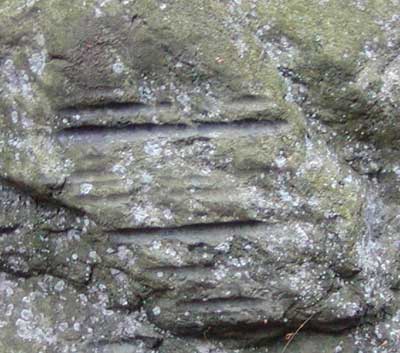 |
We will examine the grooves in the boulders created by
the towropes of boats as they wound around the canal Ox Bow. The remains
of Maple Meadow Brook Aqueduct and a stone quarry used in the
construction of the aqueduct will also be explored.
Directions: From Route 128/95 take exit 35 in Woburn. Follow Route 38 (Main St.) north 2.4 miles to the Wilmington Town Park on the left just prior to the railroad overpass. For more information please call: Bill Gerber (978-251-4971) or Roger Hagopian (781-861-7868) or see our web site - www.middlesexcanal.org. |
The General Sullivan
by Howard B. Winkler, Treasurer
I took a second glance when I first saw Louis Linscott’s lovely line drawing of a canal packet boat bearing the name, General Sullivan, see page 72, The Old Middlesex Canal by Mary Stetson Clarke.
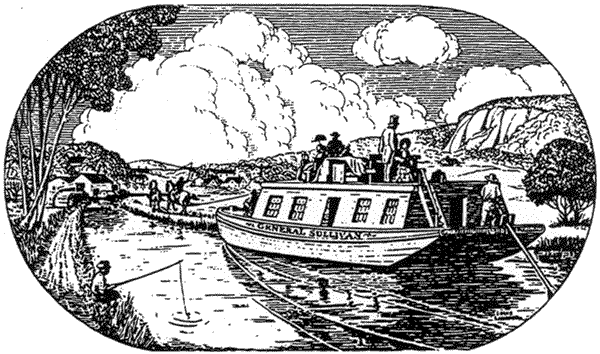
I knew that James Sullivan, the man who conceived and promoted the idea to connect the Merrimack River to Boston Harbor, had been Attorney General of the Commonwealth, but I also knew that there was General Sullivan of War of Independence fame. I wondered which Sullivan the packet boat was named after.
The National Cyclopedia of American Biography lists under James Sullivan his brother John, and the entry under John Sullivan lists James as his brother. The brothers were born in Berwick, Maine, John in 1740 and James in 1744. Both brothers had very distinguished careers. John rose to the rank of Major General in the Continental Army, and his most notable exploit is recorded in history as the Sullivan Expedition. It was a punitive mission to lay waste the infrastructure of the Iroquois Nation in New York State for siding with the British and raiding American colonists. He went on to become attorney general in New Hampshire and later became President of New Hampshire. He died in 1795. James was attorney general of Massachusetts from 1790 to 1807, and governor from 1807 until his death in office in 1808. Both brothers were also delegates to the Continental Congress from their respective states.
I thought to ask John Cirello, former head of the Historical Commission and now Alderman in Woburn, if he knew Linscott. He put me in touch with Lincott’s neighbor, and I learned that Linscott was dead. I could only guess why Linscott used General Sullivan and not Attorney General Sullivan in naming the boat. Perhaps his source was A New England Boyhood by Edward Everett Hale, published in 1893, with an excerpt to be found on page 90 in Clarke and also a slightly longer excerpt in Towpath Topics, September 1999, provided by Betty Bigwood. (Hale was also the author of The Man Without a Country.) Towpath Topics dated March 1965 (found at www.middlesexcanal.org) indicates that Linscott donated “many watercolors and prints of Canal scenes” to the Association. I could guess that Linscott’s research led him to Hale’s book in which Hale wrote “The General Sullivan was what was known, I think as a packet-boat, which carried passengers daily from Boston to the Merrimack River, where the name ‘Lowell’ had just been given to a part of the township of Chelmsford.” Lowell became an incorporated town in 1836 and Hale was born in 1822, so his reminiscence, published in 1893 when Hale was 71 was from a time when he was fourteen years of age. I could also guess that Linscott knew that the attorney general was addressed as general.
When I spoke to Alderman Cirello, he thought that the Attorney General would be addressed General. I sent a message to reference.department@state.ma.us at the State Library of Massachusetts and learned that “To the best of our knowledge, James Sullivan was called General Sullivan while serving as the Attorney General and Governor Sullivan while serving as the Governor.” I next called the office of Attorney General Thomas F. Reilly and spoke to a public information officer, Laurie Suher. In answer to my question, she told me that for example at a press conference Mr. Reilly would be introduced as Attorney General Thomas F. Reilly but the reporters when questioning him call him General Reilly.
I asked Thomas H. Dahill, Jr., aka, Tom, our nonpareil resident artist to modify the Linscott drawing for this article to set in the mind of any doubter, as I was, that the canal packet boat General Sullivan was named for the Attorney General.
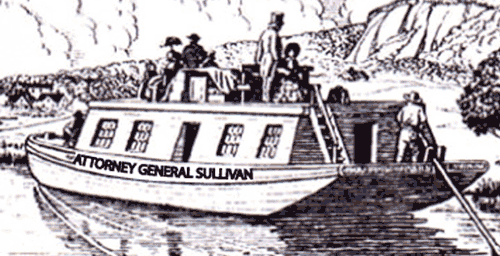
ANNUAL MEETING OF MIDDLESEX CANAL ASSOCIATION
Sunday, May 1, 2005, 2:00pm
Middlesex Canal Museum
The Annual Meeting of the Middlesex Canal Association will be held at 2:00pm on Sunday, May 1, 2005 at the Middlesex Canal Museum, 71 Faulkner Street in North Billerica, MA.
Col. Wilbar Hoxie, one of the original founders of the Middlesex Canal Association and one of our most knowledgeable members, will speak. The title of his lecture will be “Cargoes on the Canal.” One of our most frequently asked questions is “What did the canal boats carry?” You will certainly know by the end of his lecture. Please join us. The Museum will be open prior to the lecture as you may wish to see the new exhibits. The museum is handicapped accessible. Refreshments will be served. For additional information: 978-670-2740
Vice-President’s Message
by Thomas Dahill
[President Nolan Jones is on vacation.]
In the dark days of Winter the Canal Association was still alive and spreading its message. Some things are inevitably slow, such as the moving of the Billerica properties and the persevering situation with the dam on the Concord River. They are still in a state of flux with no solutions in sight.
A gala tea took place on New Years Day with members of the MCA joining with Billerica people celebrating the 350th anniversary of their incorporation. Our thanks go out to all who supported the Association in its annual appeal for funds. Another appreciation goes to those who have contributed both time and effort as baby sitters for our museum in the Faulkner Mills. As this goes out we hope we can count on many of you to act as docents in the coming weekends through the summer. There is also a continuing affection for the volunteer staff who keep the museum intact and open to the public. The museum opened on the 2nd of April, for its fourth year, to a quiet crowd which if small was attentive and enthusiastic about the displays. The exhibits are still basic explanations of the path, construction and the activity of the canal from its extension to Boston to the further extremes of New Hampshire.
A new exhibit conceived by John Reardon and featuring a bucolic view of canal activity executed by Tom Dahill is a “Dock” presentation complete with a “Passport Man” named “Mr. Lemon” and plastic fruits and vegetables which appear wholly edible. A temporary exhibit of excavated materials from the Tay Tavern in Woburn continues. A program for children in the local schools is under way. There is a great need for help in meeting, guiding and informing the minds of these youngsters in this important element of our history in scheduled times at the museum. A special committee is preparing materials for the teachers, students and those who would like to join us in this exciting venture.
On May 1st at our annual meeting our own Colonel Hoxie will give an address “Cargo on the Canal”. He will expose us to the nature of goods which flowed along the canal and the effect it had on the life and growth, both social and economic, of the people and communities. It is expected to be the high point of our Spring activities. A trip to visit sites along the Merrimac River in New Hampshire guided by Bill Gerber is being planned. It would be a bus trip including lunch and would sample the intermittent canal activities. What a wonderful Summer activity! More on that as information arrives. The membership of the society is a storehouse of information and possibilities and we have many activities to challenge your imagination and talents. We need your participation. We are all volunteers.
New Year’s Day 2005 Party at the Museum
For the second year in a row, the Middlesex Canal Association and Commission members held a gala party on New Year’s Day. This year the event celebrated the opening day of the Town of Billerica’s 350th Anniversary, whereas last year we celebrated the Middlesex Canal’s 200th Anniversary.
The highlight of the event was a debut of the “Pictorial History of North Billerica” by Eagle Scout William Zeb Couch. Zeb is a senior at Lawrence Academy and has been a member of our group since 6th grade. Zeb developed about 40 photos from glass slides that depict early North Billerica (circa 1800) in relation to the Talbot and Faulkner Mills and how they affected the early development of the area. Each photo is similarly framed in black frames, trimmed in gold and has a text description along side it to describe the significance of the photograph.
Selectwoman Ellen Day Rawlings welcomed our guests and Betty Bigwood, dressed in period garb, gave a brief history of the Canal and introduced Zeb who described his Eagle Scout project. Among the 200 attendees were 350th Committee co-chairwoman, Joan Parcewski, the crew from Billerica Access TV, a photographer from the Lowell Sun, our videographer Roger Hagopian and a few of us who also dressed in Canal day’s costumes.
As before, there were more than enough goodies to satisfy almost any taste: Baldwin apple crisp and pies, ham biscuits, hot mulled cider, birthday cake - two tables of delectables.
If we can come up with another good excuse, maybe we will do it again January 1, 2006. – Shayne Reardon
Room Rental at the Canal Museum
Are you aware that you may reserve the Museum facilities for your next family party, Christmas party, funeral reception or business meeting? The meeting room is approved for 200 people and is heated and air-conditioned. The ambiance of the wood floors, columns and ceilings adds to the enjoyment of using this historic facility. It is fully handicapped accessible and there is plenty of parking across the street next to the Mill Pond. Consider using our Museum for your next social event keeping in mind that the rental donation goes toward the support of running the Museum. Call Shayne Reardon at 978-667-1787 if you would like to discuss details.
Red Sox Trophy
The World Championship Red Sox trophy is coming to Billerica on April 23rd. After being shown in the local Little League parade about 9:00am, the trophy will then make a stop at the Museum. Ron Pare`, owner of the Faulkner Mills and the New England Baseball Museum is working on getting one of the Red Sox players to appear at the Museum to sign autographs for the public. Watch the Middlesex Canal website for upcoming developments and details.
New Exhibits Coming This 2005 Season
Look for new, interesting exhibits at the Museum this year, augmenting our always-popular existing exhibits. Our in-house artist, Tom Dahill, has been painting a new wall mural that will focus on the exhibit theme of “A Canal Landing”. This exhibit will show items that were shipped up and down the canal in its heyday and allow the public to fill out their own canal passport. Another idea being worked on is the Concord River dam.
Signs of the Middlesex Canal
Middlesex Canal Association and Commission members have been working on a signage project in Billerica for the past year and it’s beginning to pay dividends. Tourists have noticed the brown and white logo sign attached to the “attraction” signs on Rte. 3 and have followed the directional signs from the Treble Cove Road exit to the Museum with greater ease and confidence since their installation, beginning September 2004.
In addition to the directional signage at key locations in North Billerica, we have designed and installed several “canal crossing” signs in the area. At Rte 3A and Lowell Street is the location of Sprague’s Bridge, near the Talbot Mills is “Lund’s Bridge and guard lock” and on Rogers Street is a sign pointing out the location of Rogers Bridge and Lincoln’s Lock. Each of these canal-crossing signs has been donated and paid for by an interested party. The Sprague’s Bridge sign was donated in memory of Stanley and Julia Paszkiewicz, and the Rogers Bridge sign was donated by the Billerica Historical Society. These signs are particularly interesting when participating in a walking tour of North Billerica.
We have plans to install seven more crossing signs in 2005, hoping to complete the project within the Town of Billerica’s 350th anniversary celebration period. Some suggestions are: Brick Kiln Road, High Street, Pond Street, Gray Street, King’s Tavern at Andover and Salem Roads, Dignon Road (canal property was donated by Frank Dignon), and George Brown Street.
Would you like to consider sponsoring a “Canal Crossing” sign? Each sign costs $350, which includes fabrication, installation and a locator or memorial recognition sign attached below it. If you can’t sponsor the complete cost of a sign, perhaps you could contribute a portion of one.
Please contact John or Shayne Reardon (978-667-1787) if you would like to participate in the Billerica project or begin your own project in another town along the Canal. This logo sign is the standard for all upcoming signage projects along the Canal route. Hope to hear from you.
Edith Choate and Fran VerPlanck
Honorary Directors Edith Choate and Fran VerPlanck recently passed away. Edith was the wife of former Director Malcolm Choate who passed away in 1988. Fran was a former President of the Middlesex Canal Association as was her husband Burt VerPlanck who passed away in 2001.
In Loving Memory of
FRANCES BROWNE VERPLANCK
May 21,1921 to January 5, 2005
remarks of David Dettinger
Ministers are wont to declare a funeral service to be a celebration of a life well-lived. This could not be more appropriate than for that of Fran VerPlanck who passed away on January 5, 2005. Every word spoken reflected the invigorating influence her manner had on others. Three generations attested to her lively concern for her family, and its impact on their growing up.
Her characteristic enthusiasm was most visible in her delight over the wonders of nature and her desire to share knowledge, especially with children. She reveled in the woodlands near her family home in Winchester and surrounding her summer place in Chocorua, New Hampshire. She was a founder of Winchester Trails and an indefatigable guide of school groups.
Of equal importance was her interest in historical matters. She became an active member of the Middlesex Canal Association early in its founding and served as its president for four years beginning in 1977. (Her husband Burt served in the same role for three years beginning in 1990; he died in 2001. See Towpath Topics, March 2002). During those years her contributions were various; examples include nurturing close relations with the Lowell National Park, suggesting and managing the publication of the striking prints of Louis Linscott, supporting the establishment of the Middlesex Canal Commission by the Commonwealth of Massachusetts, and arranging tours, such as that to the Charlestown Navy Yard to explore the granite dry dock built by Loammi Baldwin II.
Fran will remain in our hearts and minds for her boundless energy and enthusiasm, her breathless expressions of pleasure and gratitude for our own contributions, however small, and for the fun that she brought into our lives.
Fran and Burt Ver Planck entertained us all many times in their home. At the memorial service this receipt was shared by her family
|
Fran VerPlanck’s Angel Gingerbread |
|
| ¼ cup butter ½ cup sugar 1 egg ¼ cup molasses 1 heaping cup flour 1 tsp soda ½ tsp salt ½ tsp ginger ½ tsp cinnamon ½ tsp nutmeg ½ cup boiling water |
Cream butter and sugar. Add eggs and molasses. Beat well. Combine the dry ingredients to the above mixture. Then add the boiling water. Grease and flour an 8 by 8 pan. Bake at 350°F for 25 min or until done. |
Middlesex Canal Facts
assembled by Bill Gerber, MCA Board
Owner: Middlesex Canal Company, one of the nation’s early stock
companies. The company was incorporated in 1793 and dissolved in 1860.
Dates of full operation: 1804 to 1851; sections of the canal opened earlier, as
construction of them was completed, and there was some residual use after the
canal was closed.
Length: 27¼ miles
Northern terminus: on the Merrimack River at Middlesex Village in Chelmsford, Massachusetts (now part of the city of Lowell)
Southern terminus: Charlestown, Massachusetts, along the Charles River.
Type: towpath, with lift, guard and tidal locks
Width/depth: 30 feet/3.5 feet
Locks: eventually, 18 lift locks, 2 extendable-length guard locks, and 2 tidal locks - each 80 feet long by 10 feet wide.
Special Features: Floating Towpaths, Extendable-length Guard Locks and early use of the law of Eminent Domain.
The Middlesex Canal employed two floating towpaths. Following its enlargement in 1809, one 150 foot long floating towpath enabled draft animals to pull canal boats across the Concord River millpond, at North Billerica, Massachusetts (now the site of the Middlesex Canal Museum and Visitors Center). This towpath could be “opened” to allow debris to be cleared from the upstream side and to enable boats, logs and rafts transiting the Concord River to enter and leave the canal. Another floating towpath was used for a short time in the millpond at the southern terminus in Charlestown. (It was not adequate to support tow animals and was soon replaced by a bank side towpath.)
In about 1809, at each of the Concord River guard locks, a second set of lower lock gates were built to extend the usable lock-length by several hundred feet. When employed, in place of the normal lower gates, these extended-length guard locks enabled complete “bands” of log rafts (as many as ten rafts attached one to another, end to end, to make a long “train”) to be taken across the river without requiring disassembly and reassembly.
The Middlesex Canal Company made use of the law of Eminent Domain to acquire a small portion of the land needed to build the canal. This was a very early use of this law by a private corporation. Before then it had been used to build turnpikes in Massachusetts, but prior to independence this was exclusively the King’s prerogative.
Other features: 8 aqueducts; 48 bridges serving significant roads, plus other accommodation bridges; and taverns, stables, landings (controlled cargo transfer points), mills and other facilities to support and maintain life and commercial operations on the canal.
During the construction phase, special carts were designed to facilitate removal of earth from the dig sites. These could run on wooden rails to reduce the manpower required to use them.
Cargo transported: included stone, iron ore, staves, timber, boards, plank, wood, and shingles, in large quantities, that came through the canal to Boston, as well as ashes, butter, cheese, beef, pork, cider, and grains. English goods, groceries, codfish, mackerel, salt, lime, plaster and many other articles were transported up the canal to the Merrimack River Valley.
Chief engineer: Colonel Loammi Baldwin, Sr., was the Supervisor of Construction. In this capacity, functionally, he was chief engineer for the Middlesex Canal from its inception through to completion, and for a short time thereafter. His son, Loammi II, assisted and later became known as the father of civil engineering in the US.
History of the Middlesex Canal
During the 1790s, soon after the end of the Revolutionary War, American economic
and political leaders became aware of the commercial and industrial advantages
that man-made waterways brought to England and France, and wished to emulate
their success in the United States. Such developments were also intended to bind
the new republic more closely together, as championed by Alexander Hamilton.
In Massachusetts, General Henry Knox, a Revolutionary War hero and America’s first Secretary of War, was among the early canal enthusiasts. In 1791, he headed a company, incorporated by the Massachusetts legislature, to build a 100-mile-long canal between the Connecticut and Charles Rivers. Although this canal never advanced beyond the planning stage, it, nevertheless, prepared the citizens of Massachusetts for other more economical and technically feasible canal projects. (Among these projects was the Pawtucket Canal, built to by-pass the dangerous Pawtucket Falls on the Merrimack River. Its opening predated the Middlesex Canal by about six years.)
The Middlesex Canal, which linked Charlestown, on the Charles River, to the Merrimack River at Chelmsford, was the result of efforts by merchants and other wealthy men of Boston, Medford, and surrounding towns to develop a more efficient way to tap the natural resources and reach the markets of the Merrimack River Valley in northeastern Massachusetts and New Hampshire. Incorporated on June 22, 1793, the enterprise was given ten years to complete its task. The first meeting of the Proprietors was held at the Blanchard Tavern in Medford.
James Sullivan, a highly successful lawyer who became attorney general and later Governor of Massachusetts, was an early advocate for and an investor in the Middlesex Canal. He, Loammi Baldwin and other investors joined together to form the Middlesex Canal Company and to serve on its Board of Directors, with Sullivan as president.
As Superintendent of Construction, Baldwin received early technical assistance from William Weston, an English canal engineer who was in America supervising the construction of several canals in Pennsylvania. In the summer of 1794, during a three-week visit to Massachusetts, Weston and Baldwin surveyed two proposed routes for the Middlesex Canal using a “wye-level”, an instrument first brought to America by Weston. Thereafter, Weston never returned to the canal site; but he contributed lock plans and sections adapted to the intended size of the Middlesex, provided patterns to be used to cast selected lock parts, and sometimes consulted with Baldwin by letter.
A precursor of the modern transit, the “wye-level”, together with a graduated “station staff”, i.e., a vertical measuring rod, enabled accurate elevation measurements to be made, repeatedly and continuously, along the route of survey. The results of the Weston-Baldwin survey pointed out significant elevation errors in earlier surveys made by Samuel Thompson and others. James Sullivan subsequently purchased two of these instruments, from Weston’s source in London, for the Middlesex Canal Company.
Baldwin was familiar with the technique of “puddling” - literally the sealing of a canal against leaks by packing the channel with layers of hard-packed clay. This was done at selected sections, however this technique was determined to be too expensive to be used throughout and Baldwin developed alternative means to seal the bed of the Middlesex. Generally this involved packing the earth bottom and sides, once roots and stones had been removed, and “seasoning and consolidating” the banks by flooding, draining and repacking them; and repeating this procedure until a sufficient seal was achieved. Though not as effective as puddling, and more susceptible to leakage and damage, this solution was acceptable and more affordable.
Baldwin was responsible for still other technical innovations. Among these was adapting hydraulic cement for use on the Middlesex Canal. Known since ancient times, this special cement, which hardens or “sets” underwater, was initially used to build the three locks between the northern canal terminus and the Merrimack River. Baldwin manufactured this material by grinding “trass” very fine, and mixing it with lime and sand.
“Trass” is a volcanic stone that the Middlesex Canal Company imported from the Dutch West Indies. Finding a source of volcanic stone in the western world, importing it, developing a good working process, constructing the canal locks and recording the formula was a definite contribution. Years later his formula appeared in civil engineering books, thus this may have been the first use of hydraulic cement in the USA.
Baldwin created other notable engineering structures. Particularly impressive was the aqueduct that carried the canal across the Shawsheen River. One of eight aqueducts along the canal, the trough was 188 feet long and stood 35 feet above the river. It was built of wood, like a boat-hull turned inside out, and suspended on two abutments and three central stone piers, all of which were constructed without the use of mortar.
Completed on December 31, 1803, the Middlesex Canal became an immediate success. In his 1808 survey of internal improvements, Albert Gallatin called it “the greatest work of its kind to date in the United States”. Another assessment claimed that it increased the value of New Hampshire timber, alone, by five million dollars.
Timber and masts from the forests of New Hampshire were very important items of canal commerce. These were bound into rafts at the points of origin and floated on river and canal to Boston and Medford, or by the river to Newburyport.
Dozens of canal boats, ranging from 45 to 75 feet in length and 9 to 9½ feet in width, were used. On the river, these boats were poled, rowed and sometimes sailed; on the canal, they were drawn by a horse or two, usually obtained from the company livery. Unlike other canals, families did not live aboard these boats, hence the need for taverns, boarding houses and other land based facilities to support the crews and others who traveled on the canal.
In about 1804, a tidal lock was constructed to provide access from the Charlestown mill pond (the southern terminus of the canal) into the Charles River. A fixed line, which was weighted so that it normally sank to the bottom (so as not to interfere with boats traveling on the river), was extended across the river to the Boston shore. Boatmen used this line to warp their boats across the river. Initially, the Boston end of this line terminated at Barton’s Point, where a warehouse was constructed to facilitate the transshipment of goods.
In 1805, a branch canal, incorporating two lift locks (one being a tidal lock), was constructed in Medford to access the Mystic River. This enabled the canal to better serve the many ship-building firms situated along that river. Medford was originally conceived as the southern terminus for the canal but had been bypassed, initially, for a more direct connection to Boston.
In 1808, John Langdon Sullivan, a son of James Sullivan, became the Agent for the Middlesex Canal. Among his earliest contributions was to devise and promulgate procedures for operating and using the canal, and for collecting fares, all of which were essential to the sustainment and fiscal health of the canal. He claimed to be a businessman; however Sullivan also served in an engineering capacity for the construction of several of the Merrimack River Canals and the maintenance of almost the entire system thereafter.
In 1809, a bridge was constructed across the Charles River, from Leverett Street in Boston to Lechmere Point. This was a joint effort of the Middlesex Canal Company, the Lechmere Point Company (established by Andrew Cragie and several other proprietors of the Middlesex Canal Company, and other investors), and the Newburyport Turnpike proprietors. Apparently the bridge was to include towing paths “by the sides of such bridge” for conducting boats, rafts, etc., but no record has been found to indicate that this feature was ever added; and so the fixed line, described above, continued to be used by boats crossing the river.
In about 1810, an independent firm, the Boston Mill Pond Company (MPC) constructed a canal into Haymarket Square (unofficially called the Mill Creek Canal), along the route of Boston’s present day “Canal Street”. Further on, Boston’s harbor was reached through “Mill Creek”, a natural waterway that the MPC had earlier enlarged to provide small boat access between their mill site (by Haymarket Square) and the harbor.
At about the same time, the Lechmere Point Corporation laid out a land development plan that included the construction of docks and canals in East Cambridge (across the Charles River from Boston). Named the Broad, Lechmere, South and Portland (or North) Canals, this network was intended to link all of East Cambridge and Cambridgeport, through the Middlesex Canal, to the commerce of the Merrimack Valley. The Broad Canal extended from the Charles River more than half a mile parallel to and just north of Broadway. The North Canal connected the Broad Canal to the Miller’s River, running between what is now Portland and Fulkerson streets and meeting the channel of the Miller’s River at a landing near what is now the intersection of Lambert and Gore Streets. The South Canal ran between Broadway and Canal Streets (later named Harvard Street), running parallel to the Broad Canal for about a quarter mile. The middle of the Broad Canal was connected to the east end of the South Canal via the Cross Canal near what is now Ames Street. This provided an alternate access to the Charles River. It is not clear whether the North Canal ever saw much use. The Broad Canal remained in use into the 20th Century, and its eastern end remains intact today.
In the book East Cambridge (by Susan E. Maycock and the Cambridge Historical Commission), we find the following: “The construction of the North Canal between the Miller’s River and the Broad Canal after 1811 may have been intended to provide a protected route to the canals in the Lower Port. Although one traveler tells of going to East Cambridge to board the packet boat General Sullivan for Chelmsford, there is only circumstantial evidence linking commercial traffic on the Middlesex Canal to the Cambridgeport canal system.”
To the north, the Middlesex Canal connected with the Merrimack River at Middlesex Village. By 1815 this river had been made navigable upstream to Concord, New Hampshire, by eleven relatively short canals constructed around discrete falls and rapids, (and possibly on to Plymouth, through yet an additional canal). The river downstream was navigable, made so by about 1796 by the Proprietors of Locks and Canals on Merrimack River. All together, the upstream canals, the Middlesex and Pawtucket Canals, and improvements made to nine other rapids, extended commercial transportation between Concord and Boston, and to tidewater and beyond. Additional tributary canals soon provided access to several growing villages and industrial sites along the Merrimack. At its peak, the total river and canal complex considerably exceeded 100 miles in length.
Soon after being made agent for the Middlesex Canal, John Langdon Sullivan became head of the Merrimack Boating Company (MBC), his own private company, which became the principal long-haul shipper on the canal. Also, as head of the Boston Steamboat Company, Sullivan developed several generations of steam tow boats that were used by the MBC, for more than a decade (perhaps for more than two decades), to expedite shipping on the Merrimack River. From this latter endeavor, Sullivan was awarded a total of 16 patents of his own; and he employed the rights of another eight patents held by Samuel Morey and Michael Morrison, and possibly one by Robert Fulton.
The Middlesex Canal’s period of greatest prosperity occurred between 1819 and 1833. However, in 1830, the state of Massachusetts chartered the Boston and Lowell Railroad. Ironically, the railroad, which became the canal’s greatest rival and the mechanism of its demise, used the canal over the next two years to transport rail line construction materials and its first engine. Unlike the canal, which froze in the winter, the railroad could operate throughout the year; it was also faster and more flexible. As successive rail lines extended northward, first to Lowell in 1835, then to Nashua in 1838, and finally Concord in 1842, they progressively took away the canal’s customers. Commercial traffic on the Middlesex Canal ended on November 23, 1851, though independent boaters apparently made some use of it for a year or so longer. Nine years later the Middlesex Canal Company was dissolved and the waterway abandoned. Although it ultimately succumbed to them, the complex of the Middlesex and Merrimack River Canals competed with the railroads for a decade and a half.
The early success of the Middlesex Canal helped to inspire the construction of canals in other parts of the United States, particularly the Erie Canal. States such as New York sent official delegations to inspect the successful Middlesex. The Middlesex Canal also served as a school of practical experience for early engineers, and is considered by many to be the birthplace of American Civil Engineering.
Suggestions for further Reading
Samuel P. Hadley, Boyhood Reminiscences of Middlesex Village (with Map), Contributions of the Lowell Historical Society, Volume 1, April 1913; pp. 180 to 286
Christopher Roberts, The Middlesex Canal. Cambridge, Mass: Harvard University Press, 1938.
Lewis M. Lawrence, The Middlesex Canal. Boston Mass. 1942. Manuscript reprinted in 1997 by the Middlesex Canal Association.
Mary Stetson Clark, The Old Middlesex Canal. Easton, Pa: Canal History and Technology Press, 1986.
Bert VerPlanck, Middlesex Canal Guide and Maps, Billerica Mass: The Middlesex Canal Association, 1996
Carl and Alan Seaburg and Thomas Dahill, The Incredible Ditch: A Bicentennial History of the Middlesex Canal. Medford, Mass: Anne Miniver Press, Medford Historical Society, 1997
East Cambridge, Volume I of the 5-volume Survey of Architectural History in Cambridge; Cambridge Historical Commission, Revised Edition by Susan E. Maycock. Cambridge, MA: MIT Press, 1988
Many of the records of the Proprietors of the Middlesex Canal can be found at the Mogan Center in Lowell, the Massachusetts Historical Society in Boston, and Baker Library at Harvard University in Cambridge, all in Massachusetts.
Exhibits, and some of the same records, can be seen at the Middlesex Canal Museum in North Billerica, Mass.
Links: Middlesex Canal Association: www.middlesexcanal.org and Lowell National Historic Park: www.nps.gov/lowe
Scenes from New Years Day 2004 and 2005
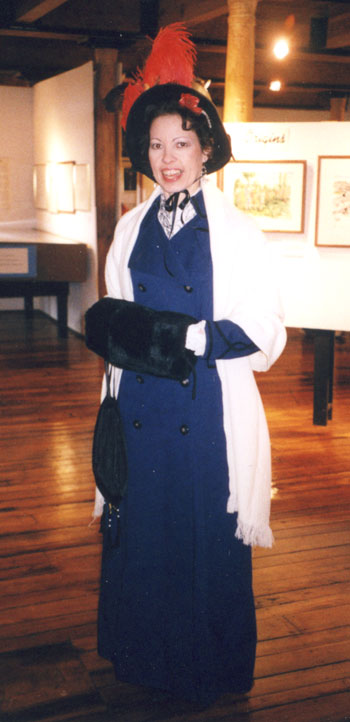 New Year's Day 2004
|
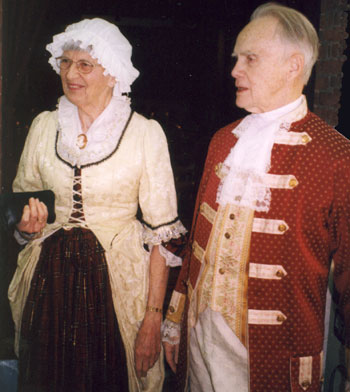 New Year's Day 2004
|
In October 2004, Dick Bauer of the the Somerville Historic Preservation Commission and Robert Winters of the Middlesex Canal Association led a bike ride along the route of the Middlesex Canal from Sullivan Square, Charlestown to the Middlesex Canal Museum in N. Billerica
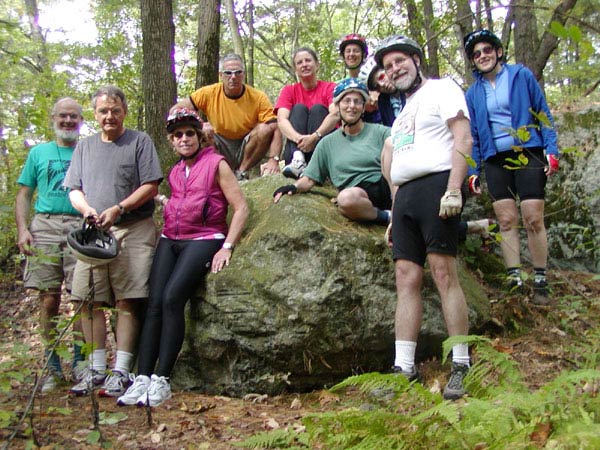
Middlesex Canal Bike Ride at the Ox Bow in the Wilmington Town Forest
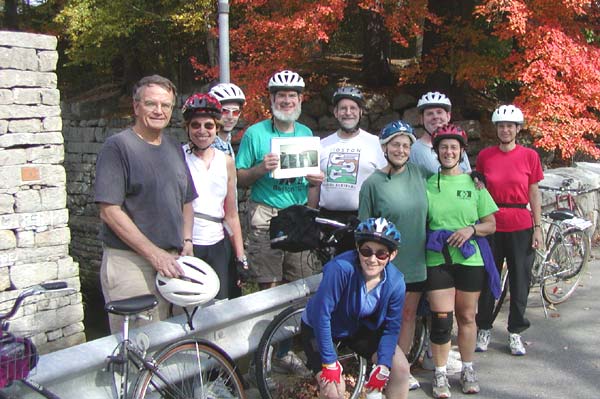
Middlesex Canal Bike Ride at the Shawsheen Aqueduct